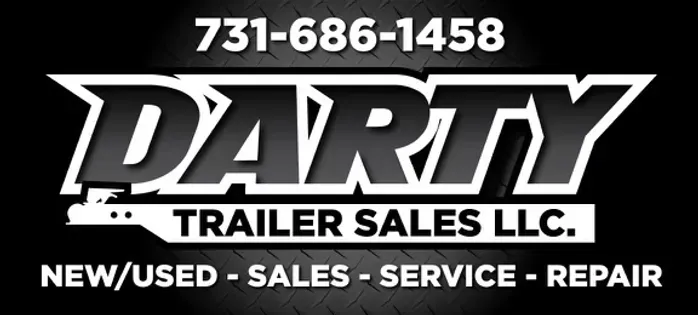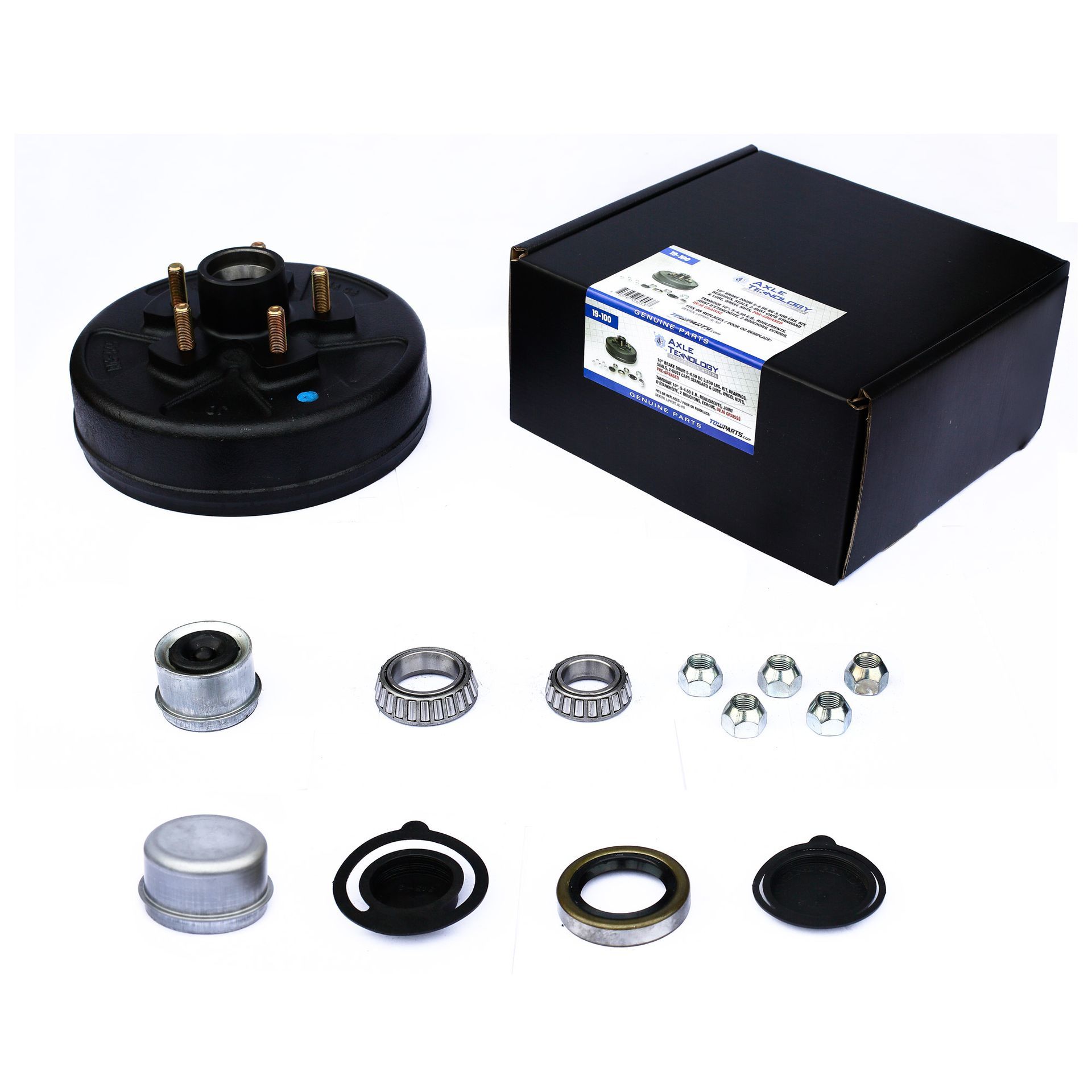
3500 lb Hub and Drum, 5 on 4.5 Bolt Pattern
$219.98
Maintenance Tips for Your 3500 lb Hub and Drum
Regular maintenance ensures the longevity and performance of your hub-and-drum assembly. Follow these tips:
- Inspect Regularly: Check for wear, cracks, or corrosion on the hub and drum. Replace if damage is evident.
- Lubricate Bearings: Use the E-Z Lube-compatible grease cap to inject fresh grease into the bearings regularly.
- Tighten Lug Nuts: Periodically check that the lug nuts are tightened to manufacturer torque specifications.
- Check Brake Shoes: Ensure the brake shoes are gripping evenly and adjust as necessary.
- Clean Components: When disassembled, clean the drum, hub, and bearings thoroughly with a solvent to remove debris and old grease.
When to Replace Your Hub and Drum
Your 3500 lb hub and drum may need replacing if you notice:
- Excessive vibration or noise during towing.
- Uneven or accelerated wear on brake shoes or tires.
- Visible cracks, rust, or deformation in the drum or hub.
- Increased stopping distances when braking.
Ignoring these signs can lead to safety hazards, so it’s essential to replace worn components promptly.
How to Replace a 3500 lb Hub and Drum
Replacing your 3500 lb hub and drum is straightforward with the right tools. Here’s how:
- Secure the Trailer: Park on a level surface, chock the wheels, and raise the trailer with a jack.
- Remove the Wheel: Loosen and remove the lug nuts to take off the wheel.
- Detach the Old Hub and Drum: Remove the grease cap, cotter pin, spindle nut, and washer. Slide off the hub and drum.
- Inspect the Spindle: Clean the spindle thoroughly and check for damage.
- Install the New Hub and Drum: Slide the pre-greased hub and drum onto the spindle. Ensure the bearings, races, and grease seal are properly seated.
- Secure the Assembly: Reinstall the spindle nut, washer, and cotter pin. Tighten according to manufacturer specifications.
- Reattach the Wheel: Replace the wheel and tighten the lug nuts securely.
- Test: Lower the trailer and test for smooth rotation and proper braking.
Safety Considerations
Safety is paramount when towing. The 3500 lb hub and drum assembly has undergone rigorous testing by both CSA and QAI to meet the highest standards of performance. Here are a few safety tips to keep in mind:
- Always use components that match your trailer’s specifications.
- Check all parts for proper installation and torque settings before hitting the road.
- Regularly inspect the hub, drum, and brakes to ensure optimal functionality.
SPECIFICATIONS
- Application: 3,500 lb trailer axles with #84 spindles
- Bolt Pattern: 5 on 4.5
- Drum Dimensions: 10″ diameter x 2-1/2″ wide
- Wheel Sizes: Compatible with 13″, 14″, 14.5″, and 15″ wheels
- Weight Capacity: 1,750 lbs per hub
- Wheel Studs: 1/2″ diameter x 1-1/4″ long
- Bearings:
- Inner: L68149 (1.378″ ID)
- Outer: L44649 (1.063″ ID)
- Races:
- Inner: L68111
- Outer: L44610
- Grease Seal: 58846 (ID: 1.719″, OD: 2.565″)
- Warranty: Limited 1-year warranty
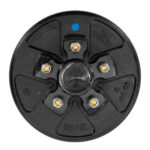
Pre-greased 3500 lb hub and drum for electric or hydraulic brakes
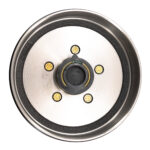
3500 lb hub and drum assembly with 5 on 4.5 bolt pattern and QAI certification
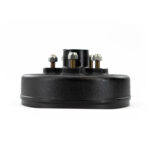
High-performance 3500 lb hub and drum for 3,500 lb trailer axles
HOW TO USE
DETAILS
Maintenance Tips for Your 3500 lb Hub and Drum
Regular maintenance ensures the longevity and performance of your hub-and-drum assembly . Follow these tips:
- Inspect Regularly: Check for wear, cracks, or corrosion on the hub and drum. Replace if damage is evident.
- Lubricate Bearings: Use the E-Z Lube-compatible grease cap to inject fresh grease into the bearings regularly.
- Tighten Lug Nuts: Periodically check that the lug nuts are tightened to manufacturer torque specifications.
- Check Brake Shoes: Ensure the brake shoes are gripping evenly and adjust as necessary.
- Clean Components: When disassembled, clean the drum, hub, and bearings thoroughly with a solvent to remove debris and old grease.
When to Replace Your Hub and Drum
Your 3500 lb hub and drum may need replacing if you notice:
- Excessive vibration or noise during towing.
- Uneven or accelerated wear on brake shoes or tires.
- Visible cracks, rust, or deformation in the drum or hub.
- Increased stopping distances when braking.
Ignoring these signs can lead to safety hazards, so it’s essential to replace worn components promptly.
How to Replace a 3500 lb Hub and Drum
Replacing your 3500 lb hub and drum is straightforward with the right tools. Here’s how:
- Secure the Trailer: Park on a level surface, chock the wheels, and raise the trailer with a jack.
- Remove the Wheel: Loosen and remove the lug nuts to take off the wheel.
- Detach the Old Hub and Drum: Remove the grease cap, cotter pin, spindle nut, and washer. Slide off the hub and drum.
- Inspect the Spindle: Clean the spindle thoroughly and check for damage.
- Install the New Hub and Drum: Slide the pre-greased hub and drum onto the spindle. Ensure the bearings, races, and grease seal are properly seated.
- Secure the Assembly: Reinstall the spindle nut, washer, and cotter pin. Tighten according to manufacturer specifications.
- Reattach the Wheel: Replace the wheel and tighten the lug nuts securely.
- Test: Lower the trailer and test for smooth rotation and proper braking.
Safety Considerations
Safety is paramount when towing. The 3500 lb hub and drum assembly has undergone rigorous testing by both CSA and QAI to meet the highest standards of performance. Here are a few safety tips to keep in mind:
- Always use components that match your trailer’s specifications.
- Check all parts for proper installation and torque settings before hitting the road.
- Regularly inspect the hub, drum, and brakes to ensure optimal functionality.
All Rights Reserved | Darty Trailer Sales LLC.
Site Designed by IP Marketing Solutions
